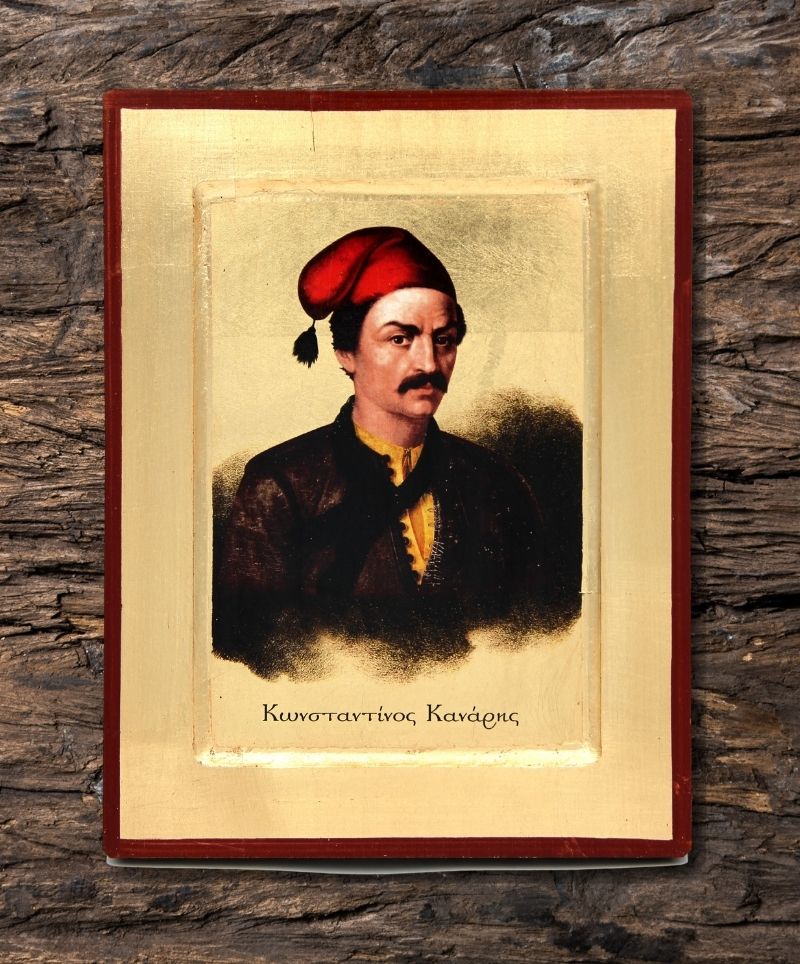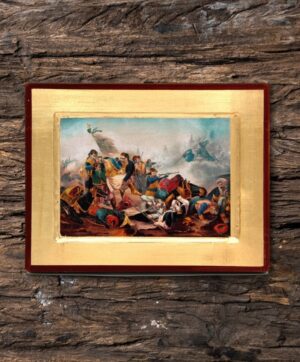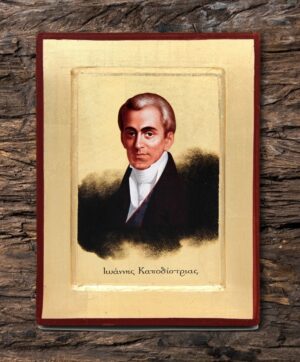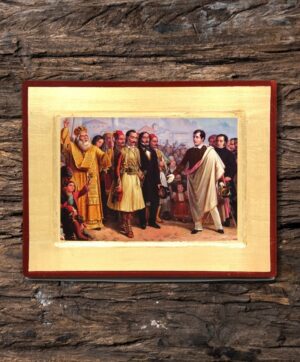Description
He was born in 1793 or 1795 in Psara Island, within a family with a long naval tradition. His father Michael or Mikes Kanargios or Kanarios repeatedly served as an elder of the island and from his marriage to Maria he had three sons, Anagnostis, Georgios and Konstantinos.
Greek revolutionary, a great figure of the naval struggle during the Greek Revolution of 1821 and later admiral and politician, who served five times as Prime Minister of Greece for a period of 33.5 years (1844, 1848-49, 1864, 1864-65 and 1877) and for 2 years and 3 months in total.
Two facts demonstrate the contribution of Kanaris as a politician in Modern Greek History: he becomes the first to complete 4 prime ministerships (1864) since the full implementation of the Constitution in the country in 1844 (like Alexandros Mavrokordatos 10 years earlier, but with the first two during the Absolute Monarchy of King Otto I) and basically the only prime minister during whose days the Parliament votes or revises the Constitution of Greece twice, in 1844 and 1864.
Then he retired from politics and privatized his house in Kypseli (56 Kypselis st.), where he received his friends and admirers every day. On May 26, 1877, at the age of 82, he returned to politics and became prime minister in the ecumenical government formed to deal with the possible consequences of the Russo-Turkish War.
The blast of the Turkish flagship
The burning of the Turkish flagship by Kanaris. Painting by Nikiforos Lytras (b. 1866-1870). Oil on canvas, 143 cm x 109 cm. Averoff Gallery, Metsovo.
In June 1822, after the Greek fleet failed to save Chios from the Turkish massacre, Kanaris undertook to put a burlot on the flagship of Kara Ali, the leader of the army that slaughtered the inhabitants and burned the island. The operation would be carried out by the artillery of Kanaris and Andreas Pipinos. Two factors helped in the project: on the one hand that the night was very dark as there was no moon and on the other hand that on the bright deck of the flagship about 2,000 Turks were celebrating Bairami and so the guard measures were incomplete. The fire from the burlot spread quickly to the ship. Before the first lifeboats could be removed from it, the fire reached the powder keg, which exploded. As a result, the victims were many. Among them Admiral Kara Alis, his officers and many sailors. Pipinos’ artillery approached the sub-flagship but failed to destroy it. But it did it a lot of damage.
The project of Alexandria
In the summer of 1825, Lazaros Koundouriotis undertook a daring venture, which, after the approval of the Greek revolutionary administration, Kanaris undertook to carry out. Muhammad Ali had assembled in Alexandria about 60 large warships and three times as many cargo ships. With these, he prepared in the summer of 1825 to send an army to revolutionary Greece (which army was used later in the fall of Messolonghi).
Kanaris’ plan was for some Greek ships to go to Alexandria and burn the Egyptian fleet. This would stop the smuggling carried out by the French, friends of Mohammed Ali, at the expense of the Greek struggle. The plan was approved and the command of the Greek fleet was assigned to Captain Manolis Tombazis.
On August 10, 1825, Tombazis and Antonios Kriezis, along with the artillery pieces of Antonios Vokos, Manolis Boutis and Kanaris, arrived outside Alexandria. At six o’clock in the evening when they arrived in front of Alexandria, a strong wind was blowing, but in order to enter the port, they needed a pilot because there were many reefs.
Kanaris considered that he had to attack immediately because such was the order of the Egyptian ships that with the wind blowing, there would be a disaster in an attack with artillery. Deceiving the pilot, he hoisted a Russian flag and entered the port alone. He tried to approach the enemy fleet but the wind suddenly dropped, so he started walking in the harbor, trying to reach the inn. When he was next to the French warship “Melissa”, he realized that he had been noticed.
So he set fire to the artillery, got into the escape boat with his sailors and tried to get out of the port. The crew of “Melissa” started firing at both Kanaris‘ artillery and boat. The wind strengthened and the artillery, burning, approached the Egyptian fleet menacingly. Kanaris, while being attacked by ships and coastal artillery, managed to escape and reach the Greek fleet, which had already raised the Greek flag. Muhammad Ali took some ships and chased the Greeks to the shores of Karamania without result.
On September 2, 1877, struck by hemiplegia, he died of a heart attack while serving as caretaker Prime Minister. His last residence is located next to the entrance of the First Cemetery in Athens, while he lived for several years in the area of Kypseli.








